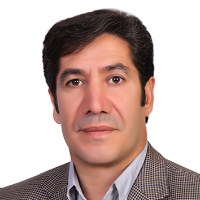Geomorphological analysis of Khiao Chai Meshginshahr river channel using Rozgan model
To determine the amount of sediment and flood zone and study water quality, engineering operations in rivers are necessary and any change in the steady state of rivers will cause a change in the physical characteristics of rivers and a new reaction in the behavior of rivers. The role of morphological studies in determining the quantity and quality of river reflection and predicting future river behavior. (Morphological studies of rivers, 2012). In Iran, many agricultural lands and good lands along rivers are eroded by floods, and many projects on the coast, such as bridges, residential areas and gardens, etc., have been destroyed. Therefore, river management is essential and the future behavior of rivers can be predicted by studying the natural response of rivers. (Sharifi Asadi, 1390). Khiavachai River starts from the confluence of the upper rivers of Dizo and Moil villages in the south and southeast of Meshginshahr. The current in Moil village is one of the main tributaries of Khiavachai. This river passes through a route about 15 km east of Meshginshahr city. In the meantime, many tributaries join the river. In addition, due to the mountainous nature of the region, the slope of the catchment towards the river is high and the slope of the riverbed is steep. The use of any river classification system is an attempt to simplify the complex relationships between rivers and their catchments. The primary purpose for classifying a river based on morphology is to understand the conditions of the river and its potential. In this regard, it is important that the classification system is a combination of river management issues, the development of river engineering projects and the discussion of river rehabilitation (Ward, 2008: 9). In the present study, according to the purpose and available data, part of the plan of the Khiavachai River canal is analyzed using the Rozgan hierarchy model Continuous change and transformation is one of the principles governing any river that along with the movement and flow of water and sediment in its bed, changes and displacements occur in other geometric characteristics of the river. On the other hand, self-regulation and variability of river canals can create hazards in the form of floods, erosion of the bed or turbulence of the bed, which is why lateral displacement and stability of rivers are of special geomorphic, engineering and ecological importance. Canal displacement can erode valuable lands, pose a threat, and threaten adjacent structures. . Therefore, the variability of rivers creates many problems for human societies, especially with regard to the efforts made to regulate or control rivers. In addition, these unintended consequences of human activities can lead to unfavorable results (Khairizadeh Arough, 2016: 4). Khiav Chai river basin is one of the basins of Qarasu river in Ardabil province, which is located in the northern slopes of Sabalan mountains and has four sub-basins, so this basin, like other basins in the country, is not immune to these problems, so It is important to study the morphological changes of river canals in order to find a suitable control solution to solve dynamic problems. Gregory et al. (2008) in an article entitled "Application of river geomorphology for river canal management" state that in the last three decades, there has been significant progress in the application of river geomorphology that can be used as a result of these studies to examine changes. Used an environment in management. Work on river canal management is more concerned with tolerance capacity, global climate change, environmental beauty, ecosystem health and public participation. The application of river geomorphology in the field of river canal changes related to the form and trend, canal change assessment, urbanization, canal construction, mining industry, the effect of engineering works, land use changes, is renewed and rehabilitated. Based on the research results, they have provided additives containing palohydrological inputs for use in river canal management that show how and how geomorphological research can be reviewed by managers. Hancock et al. (2010) used two landscape evolution models from SIBERIA and CAESAR in southeastern Australia and compared the results of this model in terms of erosion and geomorphological changes and erosion and sedimentation patterns. Hancock et al. (2011) model and simulate the effect of rainfall changes on erosion and duct movement in a study of the South East Australian Basin. In this study, they used the CAESAR cell model, which is able to show the rate of erosion and duct changes. The results show that the sensitivity of the basin to different rainfall patterns is very high. Slight changes in rainfall can lead to high sediment loads, indicating climate change. Batala et al. (2018) analyzed the geomorphological evolution of the natural river channel in the Mediterranean basin of Chile. In this study, the relationship between climate and river morphology has been investigated using remote sensing and satellite images. The results showed that morphological changes such as narrowing of the river canal and loss of vegetation by humans have caused the frequency and magnitude of flood events in this basin. Also, ten-year fluctuations in the Pacific Ocean and climatic activities and reduced discharge have led to river stability and simplification of the river channel drainage pattern.
Khiavchai watershed with an area of approximately 1300 hectares, is located on the western edge of Sabalan Mountain, in the south of Meshginshahr city. With eight sub-basins in the geographical range of 47 degrees and 38 minutes to 47 degrees and 48 minutes east longitude and 38 degrees and 11 minutes to 38 degrees 23 minutes north latitude, with a maximum altitude of 4560 meters above sea level at the location of Kasra peak in the southern heights The basin and the minimum height of 1375 meters is located at the exit of the basin at the location of Pol-e-Soltan hydrometric station. Khiavchai is the main river in this basin, which is one of the rivers with a history of landslides that is a real threat to natural resources and residents of the region. Khiavachai River is one of the important tributaries of Qarahsoo River in Meshginshahr city. The river originates from the heights of Hezar Mikh, Ai Qari, Deli Ali, Janvar Daghi and drinks the villages of Dizo, Aghbolagh, Nasrabad, Dastgir, Pashalo, Hajiloo and Meshgin city. The river was fed by springs and flows from south to north. The length of Khiavchai river is about 35 km and the average slope of its bed is 8% in mountainous areas and 4% in the plains and in the direction of south-north river flow (Farhang-e-Roods, 2005: 27). Figure (1) shows the geographical location of the study area. In order to study the morphology of Khiavachai river channel, it is necessary to use some variables and hydraulic parameters. In this regard, HEC - RAS hydrodynamic model was used as one of the most common models. The HEC-RAS model can perform water level profile calculations for variable constant flow in rivers and artificial canals in underground, supercritical and mixed flow regimes. The calculation of water surface profiles from one section to other sections is done by solving the energy equation as a standard step by step (Bruner, 2010: 27). Flow data for HEC-RAS include flow regime, flow information, baseline conditions and boundary conditions (Maroud, 2004: 29). For steady flow variable constant flow, the main method for calculating water level profiles between sections is called the direct phase method. The main computational method is based on iterative solution of energy equation. According to the flow and height of the water level in a cross section, the purpose of the standard step method is to calculate the height of the water level in the adjacent cross section. The energy equation (Bernoulli equation) is expressed as follows (Center for Hydrological Engineering, 2010, Chapter 2: 2).
Simulation results in HEC-RAS By sending information obtained from different layers of GIS to HEC-RAS and by entering other desired information such as discharge with different return periods, roughness coefficients and flow boundary conditions, this model will be able to calculate the water level at each section for return periods. Extracted the longitudinal profiles of the studied periods, its average slope, flow velocity distribution, critical water depth, wetting surface and environment, hydraulic radius, mean depth, landing number and type of flow regime at different sections and flooding levels. Due to the provision of basic geometric information in GIS, the application of the combination of HEC-RAS and GIS has a high capability in the management of flood plains in the basin. Figure (4-1) shows the water level profile of the Khiavachai watershed. The results showed that due to the introduction of separate flows for each interval and the ability of HEC-RAS software to calculate the water level profile in a step-by-step manner at the junction of water level intervals, it has been simulated correctly. It is natural that the larger the flood discharge, the more the surface will be submerged. What is important is the ratio of the extent of .
-
Investigating and prioritizing tourist attractions using the F-TOPSIS model Case study: Bostan Abad city In East Azerbaijan Province
*, Sara Ranjbar, Solmaz Bahrami
Journal of Sustainable Urban and Regional Development Studies, Autumn 2025 -
Flood Potential Assessment in the Kuzet-Topraqi Watershed Sub-basins Using the Extended Flash Flood Model
Aghil Madadi *, Amirhesam Pasban, Behrouz Nezafat Taklhe
Journal of Sustainable Urban and Regional Development Studies, Autumn 2025 -
Geotourism and geomorphological analysis and evaluation of Sarein township based on M GAM model
Fariba Esfandyari Darabad *, Behrouz Nezafat Taklhe
Journal of Sustainable Urban and Regional Development Studies, Autumn 2025 -
Optimal Site Selection of Military Bases in Meshginshahr township Using Geographic Information System (GIS) Capabilities and the Analytic Network Process (ANP) Model
Amirhesam Pasban, *
Journal of Sustainable Urban and Regional Development Studies, Autumn 2025




